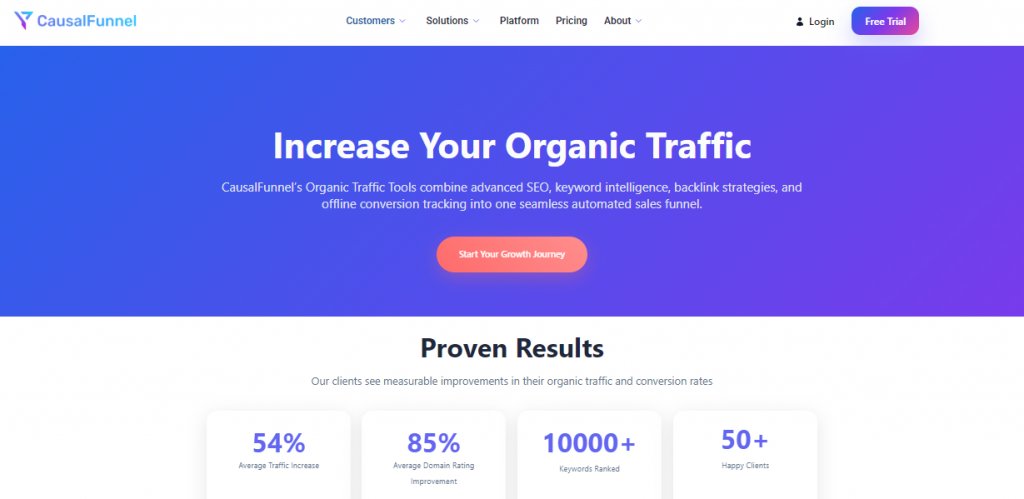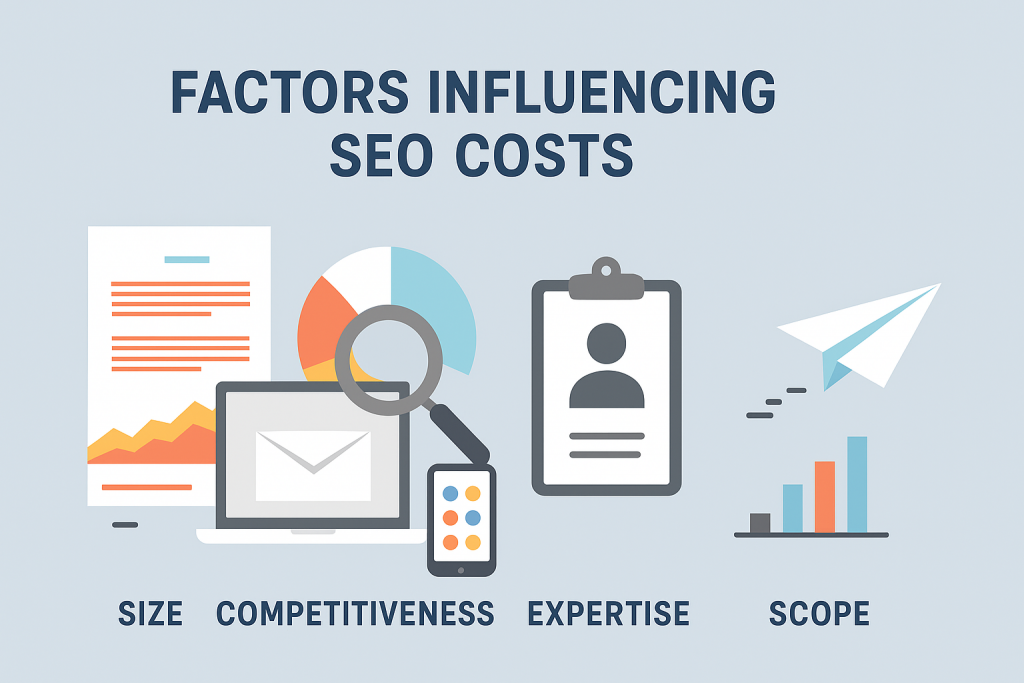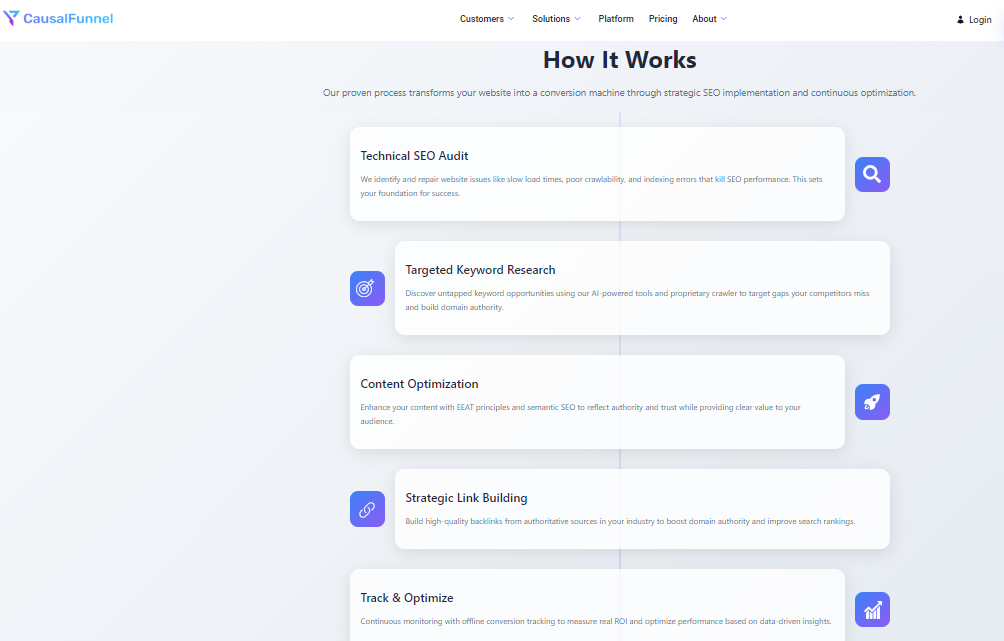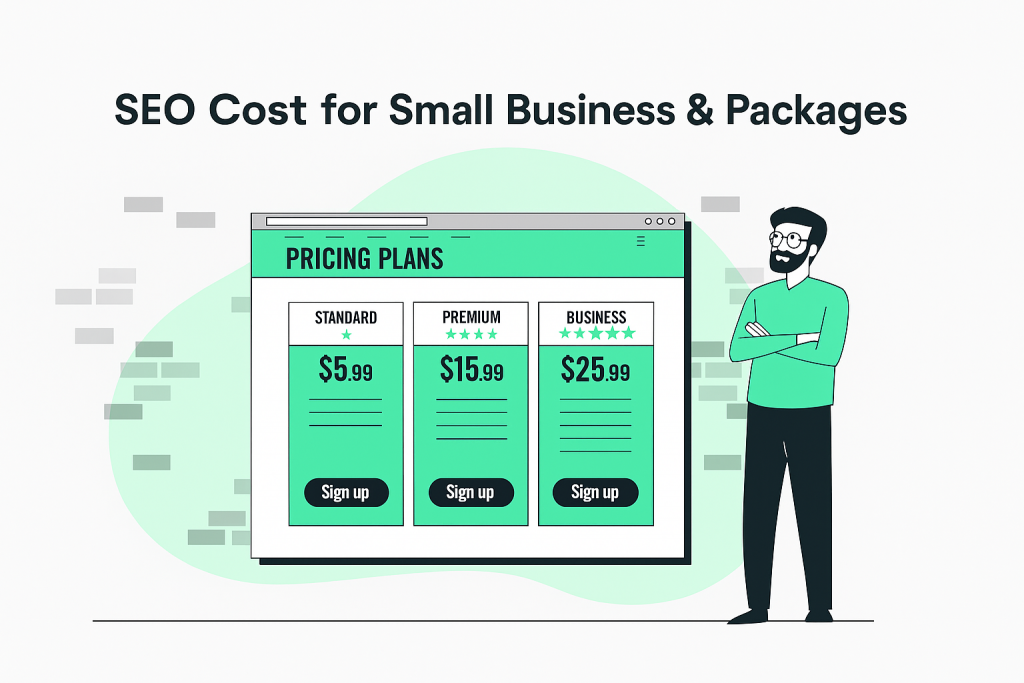If you think SEO Tools are just another expense then think again because it could turn out to be one of the smartest investments a small business can make in 2025.

But how much should you really budget for it? On an average, SEO Budget for Small Business can be anywhere between $500 to $5,000 per month, depending on the level of expertise which comes with the agency or by the freelancer hired, then you also have to look at the competition, business goals, all this in hand.
Some SEO packages for small businesses range from $1,000 to $10,000, depending on the scope of work and goals. Beyond hiring professionals, investing in SEO tools is equally important.
Tools like SEMrush, Ahrefs, and Moz provide valuable insights into keyword rankings, competitor strategies, along with backlink opportunities, helping businesses track progress and refine strategies.
Without these tools, it becomes difficult to measure ROI and stay ahead of competitors, making them a necessary part of any successful SEO plan.
What does SEO cost for small businesses? Here’s what you’ll actually pay:
Key Factors to consider:
As per these websites and their research you can illuminate opportunities for future growth
Your Business Size Matters: New startups often start with $500-$1,200 monthly. Established businesses with multiple locations invest $2,000-$4,000 monthly.

Small business SEO pricing differs greatly from big company costs. Enterprise SEO often costs $10,000+ monthly. Small businesses get great results with $500-$5,000 investments.
Why the huge difference? Small businesses focus on fewer keywords. They target local customers instead of national audiences. This focused approach works better with smaller budgets.
Service Level | Monthly Cost | Best For | Results Timeline |
Basic Local | $300–$500 | New businesses | 3-6 months |
Growth SEO | $1,500-$3,000 | Growing companies | 6-9 months |
Full Service | $3,000-$5,000 | Competitive markets | 9-12 months |
Recent surveys show important pricing trends. Search Engine Journal found 68% of small businesses pay $1,000-$3,000 monthly. HubSpot reports that businesses spending under $500 see 40% slower results.
Location affects your costs too. Big cities like New York cost 30-50% more than small towns. But higher costs often mean higher revenue potential.
The smart approach focuses on 20-100 target keywords. Big companies target thousands of keywords. Your focused strategy gets better results with less money.
Here’s an overview of the average costs associated with SEO Package for Small Business in the United States as of 2025:
Average Monthly SEO Costs for Small Businesses (2025)

Several factors can impact the cost of SEO Tools & services:
Basic SEO Services ($300–$500/month)
SEO Budget for Small Business starting their online journey:
Best for: New service businesses, local shops, startups with tight budgets.
Standard SEO Services ($1,500-$3,000/month)
Ideal for businesses ready to grow their online presence:
Best for: Growing businesses, multi-service companies, expanding to new areas.
Premium SEO Services ($3,000-$5,000/month)
Complete solution for competitive markets:
Best for: Established businesses, competitive industries like legal or medical, multiple locations.

Several factors affect your SEO investment. Understanding these helps you budget correctly and choose the right services.
Your website size directly impacts costs. A 20-page service website costs less than a 200-page online store. More pages need more optimization work.
Geographic targeting affects pricing too. Local businesses targeting one city pay less. Companies covering multiple states need bigger budgets.
Industry competition creates the biggest cost differences. Low-competition niches work with $800-$1,500 monthly. Competitive industries like law or medicine need $2,500-$5,000+ monthly.
Your website’s current health affects starting costs. Good websites need less foundation work. Poor websites require major fixes before growth begins.
Technical problems add extra costs. Old websites lacking mobile optimization need updates. These improvements cost $1,000-$3,000 upfront but help all marketing efforts.
Previous SEO work matters too. Good past work provides a foundation to build on. Bad SEO practices require 3-6 months of cleanup work.
Highly competitive industries need bigger SEO budgets. Legal, medical, and financial sectors often require $3,000-$7,000 monthly. Established competitors already invest heavily in SEO.
Niche markets offer advantages. Specialized B2B services succeed with $1,000-$2,500 monthly. Less competition means smaller budgets work better.
Local competition differs from national competition. Local service businesses need smaller budgets. But even local markets in big cities can be very competitive.
City size affects SEO pricing. Major metropolitan areas cost 30-50% more than small towns. Higher costs often match higher revenue potential.
Multiple locations increase costs. Each additional location adds $200-$500 monthly to campaigns. Market competition affects this scaling cost.
Provider location matters too. Agencies in expensive cities charge premium rates. Smaller market providers offer competitive pricing but quality varies.
Standard SEO takes 6-12 months for major results. Initial improvements show within 3-4 months. These timelines assume consistent monthly investment.
Rush projects cost 50-100% more. Accelerated timelines require higher monthly investments. But long-term success still needs consistent ongoing work.
Project-based work differs from ongoing services. Some technical fixes can be one-time projects. But sustainable SEO success requires monthly investment in content and links.
Understanding what you get for your money helps you choose wisely. Here’s what each service level includes.
This package covers local business basics:
Perfect for local service businesses just starting their SEO journey. Results typically show within 3-6 months.
This comprehensive package accelerates your growth:
Ideal for businesses ready to compete more aggressively. Expect significant improvements within 6-9 months.
The complete solution for serious growth:
Best for established businesses in competitive markets. Full results develop over 9-12 months.
Local SEO offers the best ROI for most small businesses. Here’s what local optimization costs.
Single location businesses typically invest $500-$2,000 monthly. This covers Google Business Profile optimization, local citations, and review management.
Multiple locations cost more but scale efficiently. Each additional location adds $200-$500 monthly. The first location requires the most setup work.
Geographic targeting strategy affects costs too. Businesses covering larger areas need more content and citations. This increases monthly investment requirements.
Google Business Profile Management forms the foundation. This includes posting updates, managing reviews, and optimizing your listing information.
Local Citation Building gets your business listed consistently across the web. Quality directories boost your local search rankings significantly.
Review Management protects and builds your online reputation. Quick responses to reviews show potential customers you care.
Local Content Creation targets neighborhood-specific keywords. This content helps you rank for “near me” searches.
Geographic Keyword Targeting focuses on your service areas. Local keywords often convert better than generic terms.
Deciding between doing SEO yourself or hiring professionals affects your budget and results.
SEO tools cost $100-$500 monthly for quality platforms. Popular options include Ahrefs, SEMrush, and Moz. These tools provide keyword research and tracking.
Time investment requires 20-40 hours monthly for effective DIY SEO. This includes content creation, technical fixes, and link building efforts.
The learning curve challenges slow initial progress. SEO changes constantly and requires ongoing education. Most business owners underestimate this complexity.
Hidden costs add up quickly. Website improvements, content creation tools, and design software increase expenses. Many DIY efforts fail due to incomplete execution.
Expertise and efficiency provide immediate advantages. Professional agencies know what works and avoid costly mistakes. They implement strategies faster than DIY efforts.
Tool access gives you enterprise-level capabilities. Agencies use expensive tools and software included in their service fees.
Faster results timelines justify higher costs. Professionals achieve in 6 months what DIY efforts might take 18 months to accomplish.
Risk mitigation protects your investment. Professional agencies avoid penalties and technical problems that harm DIY campaigns.
Budget constraints sometimes make DIY necessary. If you can only afford $300 monthly, DIY might be your starting option.
Business stage considerations matter too. Very new businesses might start with DIY and upgrade to professional services later.
Time availability assessment helps determine feasibility. If you can dedicate 30+ hours monthly, DIY becomes more viable.
The complexity of your market affects success probability. Simple local markets work better for DIY than competitive national markets.

Smart budget planning ensures your SEO investment delivers maximum ROI.
Revenue percentage guidelines suggest spending 5-10% of gross revenue on marketing. Within marketing budgets, allocate 20-30% specifically to SEO efforts.
Marketing budget allocation varies by business type. Service businesses often allocate more to SEO than product businesses. Local businesses benefit most from SEO investment.
ROI calculation methods help justify your investment. Track leads generated, conversion rates, and customer lifetime value. Compare these metrics to your SEO costs.
Budget flexibility planning prepares you for growth. Start conservatively but plan to increase investment as results improve.
Service-based businesses get excellent SEO returns. Professional services, contractors, and consultants see strong lead generation from SEO investment. Using SEO tools tailored for local search can amplify results.
Product-based businesses need broader strategies. E-commerce requires more content and technical work. Budget accordingly for these additional requirements.
E-commerce considerations include product optimization and category pages. These businesses need larger initial investments but achieve scalable growth.
Seasonal business adjustments help maximize ROI. Increase SEO investment before peak seasons. Reduce spending during slower periods to manage cash flow.
Understanding realistic timelines and returns helps set proper expectations for your SEO investment.
Month 1-3 focuses on foundation building. Technical fixes, keyword research, and initial content creation happen during this period. Don’t expect major traffic increases yet.
Month 4-6 brings initial improvements. You’ll see keyword ranking improvements and traffic increases. Lead generation typically begins during this timeframe.
Month 7–12 Growth
By months 7–12, many businesses see stronger SEO results. Organic traffic may double or triple depending on competition and strategy. Lead quality improves as content attracts more relevant prospects. SEO tools like Google Analytics confirm these trendlines and ROI.
In terms of Long-Term ROI
From year two onward, SEO often delivers compounding growth. Strong foundations in content and authority lead to sustained visibility and better leads. Analytics make it clear how these long-term efforts drive ongoing business growth.
Traffic growth metrics provide clear progress indicators. Monitor organic sessions, page views, and time on site. Quality traffic engages longer with your content.
Lead generation tracking connects SEO to business results. Track form submissions, phone calls, and email inquiries from organic search.
Revenue attribution methods show true ROI. Use Google Analytics to track conversions and sales from organic traffic.
Local visibility improvements matter for local businesses. Monitor local pack rankings, Google Business profile views, and direction requests.
Average ROI ranges from 300-500% for small business SEO. Service businesses often achieve higher returns than product businesses.
Small business success stories provide realistic expectations. Most successful campaigns break even within 6-8 months. Profits accelerate significantly after the first year.
Realistic expectation setting prevents disappointment. SEO requires patience and consistent investment. Quick fixes rarely deliver lasting results.
Extremely cheap SEO often costs more in the long run. Here’s how to avoid expensive mistakes.
Under $500 monthly services rarely deliver real results. Quality SEO requires substantial time investment. Extremely low prices usually mean poor execution.
Guaranteed results promises indicate inexperienced providers. No one can guarantee specific Google rankings. Ethical SEO professionals focus on improvement trends.
No contract transparency suggests hidden costs or poor practices. Quality providers explain their methods and pricing clearly.
Offshore quality concerns affect many cheap services. Language barriers and different business practices create communication problems. Time zone differences complicate support.
Google penalties risk can destroy your online presence. Poor quality backlinks and keyword stuffing trigger penalties. Recovery often costs thousands of dollars.
Recovery costs exceed prevention costs significantly. Fixing penalty damage costs 3-5x more than proper SEO. Lost business during recovery compounds the expense.
Lost opportunity costs accumulate over time. Months spent on ineffective SEO delay real growth. Competitors gain advantages while you recover from poor choices.
Reputation damage affects customer trust. Cheap SEO tactics can harm your brand reputation online. Professional reputation repair costs significant time and money.
Making the right choice requires careful evaluation and planning.
Service delivery specifics clarify what you’re buying. Ask for detailed service descriptions and monthly deliverables. Understanding expectations prevents disappointment later.
Reporting and transparency show professional standards. Quality providers offer detailed monthly reports. They explain their methods and progress clearly.
Timeline expectations help plan your budget. Ask about realistic timeframes for different goals. Avoid providers promising unrealistic quick results.
Accountability is key in SEO, with the help of reliable providers who tend to measure progress using analytics platforms like Google Analytics and SEO tools it becomes easy to track rankings, organic traffic, leads, and conversions.
Which gives you clear metrics to evaluate ROI by analyzing this data over time, you can see exactly how SEO efforts translate into business growth.
Budget finalization comes first. Determine your comfortable monthly investment level. Consider both startup costs and ongoing monthly expenses.
The provider research process takes time but prevents problems. Check references, read reviews, and verify credentials. Quality providers welcome scrutiny.
Contract evaluation protects your investment. Understand cancellation terms, deliverables, and payment schedules. Avoid long-term contracts until proven results.
Implementation planning ensures smooth startup. Discuss timeline expectations, communication methods, and success metrics. Clear planning prevents misunderstandings.
Ready to start your SEO journey? Begin with a realistic budget assessment and provider research, you can also opt for SEO Tools which provides valuable insights and data to help your business grow. The right SEO investment transforms your business growth trajectory.
There are several SEO tools and services that cost around $500-$5,000 monthly depending on your goals and competition. However some of the most successful businesses invest $1,500-$3,000 monthly for comprehensive coverage.
Smart investment focuses on local SEO first. Build your foundation with Google Business Profile optimization and local citations. Add content marketing and link building as your budget grows.
Remember that SEO delivers compound returns over time. Initial months build the foundation while later months generate exponential growth. Patience and consistent investment create the best results.
$500 monthly represents the practical minimum for professional SEO. Anything less rarely delivers meaningful results. DIY approaches might work with smaller budgets but require significant time investment.
Initial improvements appear within 3-4 months. Significant traffic increases typically occur in months 6-9. Full ROI usually develops over 12-18 months with consistent investment.
Yes, through focused local and niche targeting. Small businesses can't match enterprise budgets but can win specific market segments. Local SEO levels the playing field significantly.
Local SEO provides the highest ROI for most small businesses. Google Business Profile optimization, local citations, and review management deliver immediate benefits. Content marketing accelerates long-term growth.
Track organic traffic growth, keyword rankings, and lead generation. Quality SEO shows steady monthly improvement. Your provider should deliver detailed monthly reports showing progress.
Empowering businesses to optimize their conversion funnels with AI-driven insights and automation. Turn traffic into sales with our advanced attribution platform.



